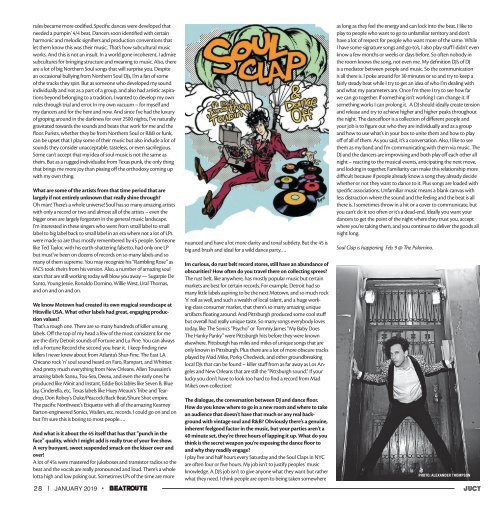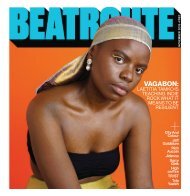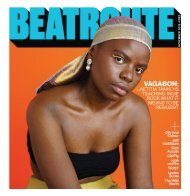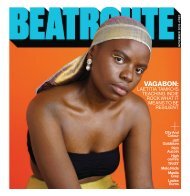Create successful ePaper yourself
Turn your PDF publications into a flip-book with our unique Google optimized e-Paper software.
ules became more codified. Specific dances were developed that<br />
needed a pumpin’ 4/4 beat. Dancers soon identified with certain<br />
harmonic and melodic signifiers and production conventions that<br />
let them know this was their music. That’s how subcultural music<br />
works. And this is not an insult. In a world gone incoherent, I admire<br />
subcultures for bringing structure and meaning to music. Also, there<br />
are a lot of big Northern Soul songs that will surprise you. Despite<br />
an occasional bullying from Northern Soul DJs, I’m a fan of some<br />
of the tracks they spin. But as someone who developed my sound<br />
individually and not as a part of a group, and also had artistic aspirations<br />
beyond belonging to a tradition, I wanted to develop my own<br />
rules through trial and error. In my own vacuum – for myself and<br />
my dancers and for the here and now. And since I’ve had the luxury<br />
of groping around in the darkness for over 2500 nights, I’ve naturally<br />
gravitated towards the sounds and beats that work for me and the<br />
floor. Purists, whether they be from Northern Soul or R&B or funk,<br />
can be upset that I play some of their music but also include a lot of<br />
sounds they consider unacceptable, tasteless, or even sacrilegious.<br />
Some can’t accept that my idea of soul music is not the same as<br />
theirs. But as a rugged individualist from Texas punk, the only thing<br />
that brings me more joy than pissing off the orthodoxy coming up<br />
with my own thing.<br />
What are some of the artists from that time period that are<br />
largely if not entirely unknown that really shine through?<br />
Oh man! There’s a whole universe! Soul has so many amazing artists<br />
with only a record or two and almost all of the artists – even the<br />
bigger ones are largely forgotten in the general music landscape.<br />
I’m interested in these singers who went from small label to small<br />
label to big label back to small label in an era where not a lot of LPs<br />
were made so are thus mostly remembered by 45 people. Someone<br />
like Ted Taylor, with his earth-shattering falsetto, had only one LP<br />
but must’ve been on dozens of records on so many labels and so<br />
many of them supreme. You may recognize his “Rambling Rose” as<br />
MC5 took theirs from his version. Also, a number of amazing soul<br />
stars that are still working today will blow you away — Sugarpie De<br />
Santo, Young Jessie, Ronaldo Domino, Willie West, Ural Thomas,<br />
and on and on and on.<br />
We know Motown had created its own magical soundscape at<br />
Hitsville USA. What other labels had great, engaging production<br />
values?<br />
That’s a rough one. There are so many hundreds of killer unsung<br />
labels. Off the top of my head a few of the most consistent for me<br />
are the dirty Detroit sounds of Fortune and Lu Pine. You can always<br />
tell a Fortune Record the second you hear it. I keep finding new<br />
killers I never knew about from Atlanta’s Shur-Fine. The East LA<br />
Chicano rock ’n’ soul sound heard on Faro, Rampart, and Whittier.<br />
And pretty much everything from New Orleans. Allen Toussaint’s<br />
amazing labels Sansu, Tou-Sea, Deesu, and even the early ones he<br />
produced like Minit and Instant, Eddie Bo’s lables like Seven B, Blue<br />
Jay, Cinderella, etc, Texas labels like Huey Meaux’s Tribe and Teardrop,<br />
Don Robey’s Duke/Peacock/Back Beat/Shure Shot empire.<br />
The pacific Northwest’s Etiquette with all of the amazing Kearney<br />
Barton-engineered Sonics, Wailers, etc. records. I could go on and on<br />
but I’m sure this is boring to most people….<br />
And what is it about the 45 itself that has that “punch in the<br />
face” quality, which I might add is really true of your live show.<br />
A very buoyant, sweet suspended smack on the kisser over and<br />
over!<br />
A lot of 45s were mastered for jukeboxes and transistor radios so the<br />
beat and the vocals are really pronounced and loud. There’s a whole<br />
lotta high and low poking out. Sometimes LPs of the time are more<br />
28 | <strong>JANUARY</strong> <strong>2019</strong> • <strong>BEATROUTE</strong><br />
nuanced and have a lot more clarity and tonal subtlety. But the 45 is<br />
big and brash and ideal for a wild dance party….<br />
Im curious, do rust belt record stores, still have an abundance of<br />
obscurities? How often do you travel there on collecting sprees?<br />
The rust belt, like anywhere, has mostly popular music but certain<br />
markets are best for certain records. For example, Detroit had so<br />
many little labels aspiring to be the next Motown, and so much rock<br />
’n’ roll as well, and such a wealth of local talent, and a huge working-class<br />
consumer market, that there’s so many amazing unique<br />
artifacts floating around. And Pittsburgh produced some cool stuff<br />
but overall had really unique taste. So many songs everybody loves<br />
today, like The Sonics “Psycho” or Tommy James “My Baby Does<br />
The Hanky Panky” were Pittsburgh hits before they were known<br />
elsewhere. Pittsburgh has miles and miles of unique songs that are<br />
only known in Pittsburgh. Plus there are a lot of more obscure tracks<br />
played by Mad Mike, Porky Chedwick, and other groundbreaking<br />
local DJs that can be found – killer stuff from as far away as Los Angeles<br />
and New Orleans that are still the “Pittsburgh sound.” If your<br />
lucky you don’t have to look too hard to find a record from Mad<br />
Mike’s own collection!<br />
The dialogue, the conversation between DJ and dance floor.<br />
How do you know where to go in a new room and where to take<br />
an audience that doesn’t have that much or any real background<br />
with vintage soul and R&B? Obviously there’s a genuine,<br />
inherent feelgood factor in the music, but your parties aren’t a<br />
40 minute set, they’re three hours of lapping it up. What do you<br />
think is the secret weapon you’re exposing the dance floor to<br />
and why they readily engage?<br />
I play five and half hours every Saturday and the Soul Claps in NYC<br />
are often four or five hours. My job isn’t to justify peoples’ music<br />
knowledge. A DJ’s job isn’t to give anyone what they want but rather<br />
what they need. I think people are open to being taken somewhere<br />
as long as they feel the energy and can lock into the beat. I like to<br />
play to people who want to go to unfamiliar territory and don’t<br />
have a lot of respect for people who want more of the same. While<br />
I have some signature songs and go-to’s, I also play stuff I didn’t even<br />
know a few months or weeks or days before. So often nobody in<br />
the room knows the song, not even me. My definition DJ’s of DJ<br />
is a mediator between people and music. So the communication<br />
is all there is. I poke around for 30 minutes or so and try to keep a<br />
fairly steady beat while I try to get an idea of who I’m dealing with<br />
and what my parameters are. Once I’m there I try to see how far<br />
we can go together. If something isn’t working I can change it. If<br />
something works I can prolong it. A DJ should ideally create tension<br />
and release and try to achieve higher and higher peaks throughout<br />
the night. The dancefloor is a collection of different people and<br />
your job is to figure out who they are individually and as a group<br />
and how to use what’s in your box to unite them and how to play<br />
off of all of them. As you said, it’s a conversation. Also, I like to see<br />
them as my band and I’m communicating with them via music. The<br />
DJ and the dancers are improvising and both play off each other all<br />
night – reacting to the musical events, anticipating the next move,<br />
and locking in together. Familiarity can make this relationship more<br />
difficult because if people already know a song they already decide<br />
whether or not they want to dance to it. Plus songs are loaded with<br />
specific associations. Unfamiliar music means a blank canvas with<br />
less distraction where the sound and the feeling and the beat is all<br />
there is. I sometimes throw in a hit or a cover to communicate, but<br />
you can’t do it too often or it’s a dead-end. Ideally you want your<br />
dancers to get the point of the night where they trust you, accept<br />
where you’re taking them, and you continue to deliver the goods all<br />
night long.<br />
Soul Clap is happening Feb. 9 @ The Palomino.<br />
PHOTO: ALEXANDER THOMPSON<br />
JUCY


















